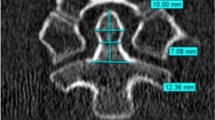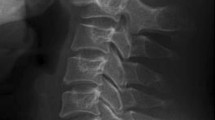Abstract
Introduction
Odontoid diameter in some individuals may not be large enough to accommodate two 3.5-mm cortical screws for anterior odontoid fracture fixation. The study was performed to evaluate, in a Brazilian population, the diameter of the odontoid process and the feasibility of using two 3.5-mm cortical screws for anterior odontoid fracture fixation.
Materials and methods
Computed tomographic (CT) scans of 88 adult patients (aged 18–78 years) were analyzed; 40 patients (45%) were male (mean age: 43.08 years) and 48 (55%) were female (mean age: 43.39 years). The minimum external and internal anteroposterior and transverse diameters of the odontoid process on sagittal and coronal planes were measured on CT multiplanar reconstructions of the cervical spine.
Results
The mean value of the minimum external anteroposterior diameter was 10.83 ± 1.08 and 7.53 ± 1.10 mm for the minimum internal anteroposterior diameter. The mean value of the minimum external transverse diameter was 9.19 ± 0.91 and 6.07 ± 1.08 mm for the minimum internal transverse diameter. The mean AP diameter was significantly larger than the mean transverse diameter; 57 (65%) individuals had the minimum external transverse diameter >9.0 mm that would allow the insertion of two 3.5-mm cortical screws with tapping, and five (6%) individuals had the minimum internal transverse diameter >8.0 mm that would allow the insertion of two 3.5-mm cortical screws without tapping.
Conclusions
The insertion of two 3.5-mm cortical screws was possible for anterior fixation of odontoid fracture in 57 (65%) individuals of our study, and there was no statistical difference between males and females.





Similar content being viewed by others
References
Anderson LD, D’Alonzo RT (1974) Fractures of the odontoid process of the axis. J Bone Joint Surg Am 56:1663–1674
Apfelbaum RI, Lonser RR, Veres R, Casey A (2000) Direct anterior screw fixation for recent and remote odontoid fractures. J Neurosurg 93:227–236
Bohler J (1982) Anterior stabilization for acute fractures and non-unions of the dens. J Bone Joint Surg Am 64:18–27
Grauer JN, Shafi B, Hilibrand A, Harrop JS, Kwon BK, Beiner JM, Albert TJ, Fehlings MG, Vaccaro AR (2005) Proposal of a modified, treatment-oriented classification of odontoid fractures. Spine J 5:123–129
Henry AD, Bohly J, Grosse A (1999) Fixation of odontoid fractures by an anterior screw. J Bone Joint Surg Br 81:472–477
Hubner AR, Spinelli LF, Grosse A (1999) Decisão no tratamento das fraturas do odontóide. COLUNA/COLUMNA 9:43–48
Jenkins JD, Coric D, Branch CL Jr (1998) A clinical comparison of one- and two-screw odontoid fixation. J Neurosurg 89:366–370
Maak TG, Grauer JN (2006) The contemporary treatment of odontoid injuries. Spine (Phila Pa 1976) 31:S53–S60
Nakanishi T, Sasaki T, Takahata T, Aoki Y, Sueyasu M, Uzawa M, Washiya S, Imanaka K (1980) Internal fixation of odontoid process. Orthop Surg Traumatol 23:399–406
Nucci RC, Seigal S, Merola AA, Gorup J, Mroczek KJ, Dryer J, Zipnick RI, Haher TR (1995) Computed tomographic evaluation of the normal adult odontoid. Implications for internal fixation. Spine (Phila Pa 1976) 20:264–270
Patel AA, Lindsey R, Bessey JT, Chapman J, Rampersaud R (2010) Surgical treatment of unstable type II odontoid fractures in skeletally mature individuals. Spine (Phila Pa 1976) 35:S209–S218
Sasso R, Doherty BJ, Crawford MJ, Heggeness MH (1993) Biomechanics of odontoid fracture fixation. Comparison of the one- and two-screw technique. Spine (Phila Pa 1976) 18:1950–1953
Schaffler MB, Alson MD, Heller JG, Garfin SR (1992) Morphology of the dens. A quantitative study. Spine (Phila Pa 1976) 17:738–743
Yusof MI, Yusof AH, Abdullah MS, Hussin TM (2007) Computed tomographic evaluation of the odontoid process for two-screw fixation in type-II fracture: a Malaysian perspective. J Orthop Surg (Hong Kong) 15:67–72
Conflict of interest
None of the authors has any potential conflict of interest.
Author information
Authors and Affiliations
Corresponding author
Rights and permissions
About this article
Cite this article
Daher, M.T., Daher, S., Nogueira-Barbosa, M.H. et al. Computed tomographic evaluation of odontoid process: implications for anterior screw fixation of odontoid fractures in an adult population. Eur Spine J 20, 1908–1914 (2011). https://doi.org/10.1007/s00586-011-1879-2
Received:
Revised:
Accepted:
Published:
Issue Date:
DOI: https://doi.org/10.1007/s00586-011-1879-2




